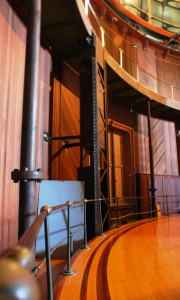Life unexpectedly detoured me through central California last week, so I thought I would take advantage of its (relative) proximity to visit Lick Observatory. The observatory is draped across the uppermost peaks of Mt. Hamilton in the Diablo Range east of San Jose. It’s open to the public on most days of the year, but hours and days are restricted during the winter months, so check the opening schedule before making the drive.
The daytime public program is focused on the historic instruments of the observatory, especially the Great Refractor installed under the dome custom-built for it in 1887. This 36″ telescope, the lenses for which were ground by Alvan Clark & Son (the same workshop that ground the lenses for the refractors at the Yerkes and Cincinnati observatories), lives in the largest of two domes flanking the Main Building of the observatory. A 12″ reflector that had been purchased second-hand from Alvan Clark originally lived in the smaller dome at the opposite end of the building; it now houses the 40″ Nickel Reflector. One has to wonder what instrumental astronomy would have looked like in the U.S. at the end of the nineteenth century had Alvan Clark not been around to polish the needed lenses and mirrors.
As you can see from the photo above, the Great Refractor was protected by a dome that was designed with a concern for aesthetics as much as functionality. The underside of the dome was tinted with a color meant to evoke the heavens and the walls were finished with California redwood paneling. James Lick might’ve been an odd guy, but he knew his woodworking.
The floor of the observatory, which was finished with mahogany and ringed with brass railings, was designed to move up and down along a vertical system of spur gears. This cleverness allowed observers to stand on a solid surface while looking through the eyepiece of the telescope, rather than on top of a ladder as was customary with large instruments.
In addition to the guide-led program in the Main Building, there is also a small viewing gallery open to the public in the dome of the Shane 3-meter Reflector. I thought the gallery was under-used, in that the interpretive materials were limited, and public view of the instrument was partially blocked by unidentified objects. The most interesting part of the display was the absolutely ancient black-and-white publicity movie that talked about the early history of the instrument. The corners on Mt. Hamilton Road are so tight that they had to use a relay system to get the 120″ glass for the mirror to its destination, using a crane to transfer the glass from the bed of the truck approaching the corner to the truck waiting on the other side of the corner. You can see below that many of the corners are more than just simple switchbacks, they actually start to double-back on themselves.
As an architectural historian, I thought the public program was fascinating; I stood through it twice, in fact. As I was wandering around the larger complex, however, I couldn’t help but wish that public programs spent more time explicating current research and observing practices. I suppose it’s not very practical to demonstrate the Automated Planet Finder or the Katzman Automatic Imaging Telescope; most observational data is crunched with computers manned by tired postdocs. (Take a look at a panoramic view of the control room for the Shane 3-meter during an observing run, for instance. Not enough drama for tourists, I’m pretty sure.) But sometimes I wonder if programs focused on the historical leave the public with the feeling that little has changed in instrumental astronomy in the last century, or if it has, that those changes aren’t important or comprehensible. There are at least ten domes at Lick Observatory and new instruments are being added or adapted on a regular basis. I think if the University of California is depending on public dollars to fund the research at the observatory, it might be good to put more information about current research in visitors’ hands. I enjoyed the slide displays of recent discoveries and accomplishments that lined the halls of the Main Building, but I think it would be more effective to have some of those research goals articulated by the guide during public presentations.
Just a side note: if you’re driving up to Lick Observatory from San Jose, be careful. This is a very popular training route for cyclists (in fact, the Amgen Tour of California passed through the day before I went up), so don’t whip around those blind curves—it’s not nice to run over cyclists with your car.




